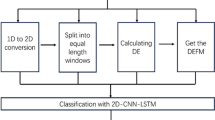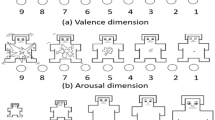Abstract
The research on emotion classification based on electroencephalogram(EEG) signal has been increasingly studied for its applicability in human-computer interaction. However, the effectiveness of EEG emotion classification is often suboptimal due to person, time, and equipment variations in EEG data, and this remains a major challenge in real-world applications. For the purpose of improving the identification of EEG emotion, this paper proposes a new method for classifying emotion, called Joint Adaptation Network-Variational Mode Decomposition (JAN-VMD), which combines the universality and effectiveness of transfer learning in the field of EEG emotion classification. First, we optimize the differential mode decomposition based on multiple group differences. Then, we apply the optimized differential mode decomposition combined with transfer learning to various scenarios of EEG-based emotion classification experiments. Finally, experimental results confirmed that the proposed JAN-VMD model in this paper effectively improves the accuracy of EEG-based emotion classification. The experiments demonstrated that the proposed method not only effectively addresses the issue of differential recognition in deep neural networks but also enhances recognition accuracy on the basis of transfer learning algorithms, proving the feasibility and superiority of the proposed approach.
Access this chapter
Tax calculation will be finalised at checkout
Purchases are for personal use only
Similar content being viewed by others
References
Canal, F.Z., et al.: A survey on facial emotion recognition techniques: a state-of-the-art literature review. Inf. Sci. 582, 593–617 (2022)
Cortes, C., Vapnik, V.: Support-vector networks. Mach. Learn. 20, 273–297 (1995)
Doma, V., Pirouz, M.: A comparative analysis of machine learning methods for emotion recognition using EEG and peripheral physiological signals. J. Big Data 7(1), 1–21 (2020)
Forgas, J.P.: Mood effects on cognition: affective influences on the content and process of information processing and behavior. In: Emotions and Affect in Human Factors and Human-Computer Interaction, pp. 89–122 (2017)
Ko, W., Jeon, E., Jeong, S., Suk, H.I.: Multi-scale neural network for EEG representation learning in BCI. IEEE Comput. Intell. Mag. 16(2), 31–45 (2021)
Lan, Z., Sourina, O., Wang, L., Scherer, R., Müller-Putz, G.R.: Domain adaptation techniques for EEG-based emotion recognition: a comparative study on two public datasets. IEEE Trans. Cogn. Dev. Syst. 11(1), 85–94 (2018)
Li, J., et al.: Cross-subject EEG emotion recognition combined with connectivity features and meta-transfer learning. Comput. Biol. Med. 145, 105519 (2022)
Li, Y., Zheng, W., Wang, L., Zong, Y., Cui, Z.: From regional to global brain: a novel hierarchical spatial-temporal neural network model for EEG emotion recognition. IEEE Trans. Affect. Comput. 13(2), 568–578 (2019)
Liu, H., Guo, H., Hu, W.: EEG-based emotion classification using joint adaptation networks. In: 2021 IEEE International Symposium on Circuits and Systems (ISCAS), pp. 1–5. IEEE (2021)
Long, M., Cao, Y., Wang, J., Jordan, M.: Learning transferable features with deep adaptation networks. In: International Conference on Machine Learning, pp. 97–105. PMLR (2015)
Long, M., Zhu, H., Wang, J., Jordan, M.I.: Deep transfer learning with joint adaptation networks. In: International Conference on Machine Learning, pp. 2208–2217. PMLR (2017)
Pan, S.J., Tsang, I.W., Kwok, J.T., Yang, Q.: Domain adaptation via transfer component analysis. IEEE Trans. Neural Netw. 22(2), 199–210 (2010)
Singh, Y.B., Goel, S.: A systematic literature review of speech emotion recognition approaches. Neurocomputing 492, 245–263 (2022)
Song, T., Zheng, W., Song, P., Cui, Z.: EEG emotion recognition using dynamical graph convolutional neural networks. IEEE Trans. Affect. Comput. 11(3), 532–541 (2018)
Wang, Y., et al.: A systematic review on affective computing: emotion models, databases, and recent advances. Information Fusion 83, 19–52 (2022)
Yang, F., Zhao, X., Jiang, W., Gao, P., Liu, G.: Multi-method fusion of cross-subject emotion recognition based on high-dimensional eeg features. Front. Comput. Neurosci. 13, 53 (2019)
Zhu, Z., Lin, K., Jain, A.K., Zhou, J.: Transfer learning in deep reinforcement learning: a survey. IEEE Trans. Pattern Anal. Mach. Intell. 45(11), 13344–13362 (2023)
Author information
Authors and Affiliations
Corresponding author
Editor information
Editors and Affiliations
Rights and permissions
Copyright information
© 2024 The Author(s), under exclusive license to Springer Nature Singapore Pte Ltd.
About this paper
Cite this paper
Zhao, Q., Wu, J., Liu, H. (2024). A New Emotion Classification Method Based on JAN-VMD. In: Cao, C., Chen, H., Zhao, L., Arshad, J., Asyhari, T., Wang, Y. (eds) Knowledge Science, Engineering and Management. KSEM 2024. Lecture Notes in Computer Science(), vol 14885. Springer, Singapore. https://doi.org/10.1007/978-981-97-5495-3_2
Download citation
DOI: https://doi.org/10.1007/978-981-97-5495-3_2
Published:
Publisher Name: Springer, Singapore
Print ISBN: 978-981-97-5494-6
Online ISBN: 978-981-97-5495-3
eBook Packages: Computer ScienceComputer Science (R0)




